Introduction to the Different Types Of Network Topologies
Network topology refers to the structure of the topology of a network. A network topology could consist of several types of routers with many connections to other routers.
Network topologies are an essential aspect of any computer network, helping to determine how devices are connected and communicate with each other. Understanding the various types of network topologies is crucial for network administrators and professionals in the field of information technology.
In this blog post, we will explore the different types of network topologies, how they work and the suitability and limitations of each network topology.
Bus Topology
Bus topology is a computer networking concept that provides a computer with a direct connection to several other computers in a network. The computer providing the connection between those other computers is referred to as the bus topology switch. There are several ways to implement bus topology connections, the best of which is to use a computer with four, eight, or sixteen sockets.
This structure is prevalent for local area networks. In this structure or topology, a single network cable runs in the building or campus, and all nodes are linked along with this communication line with two endpoints called the bus or backbone, as shown figure:
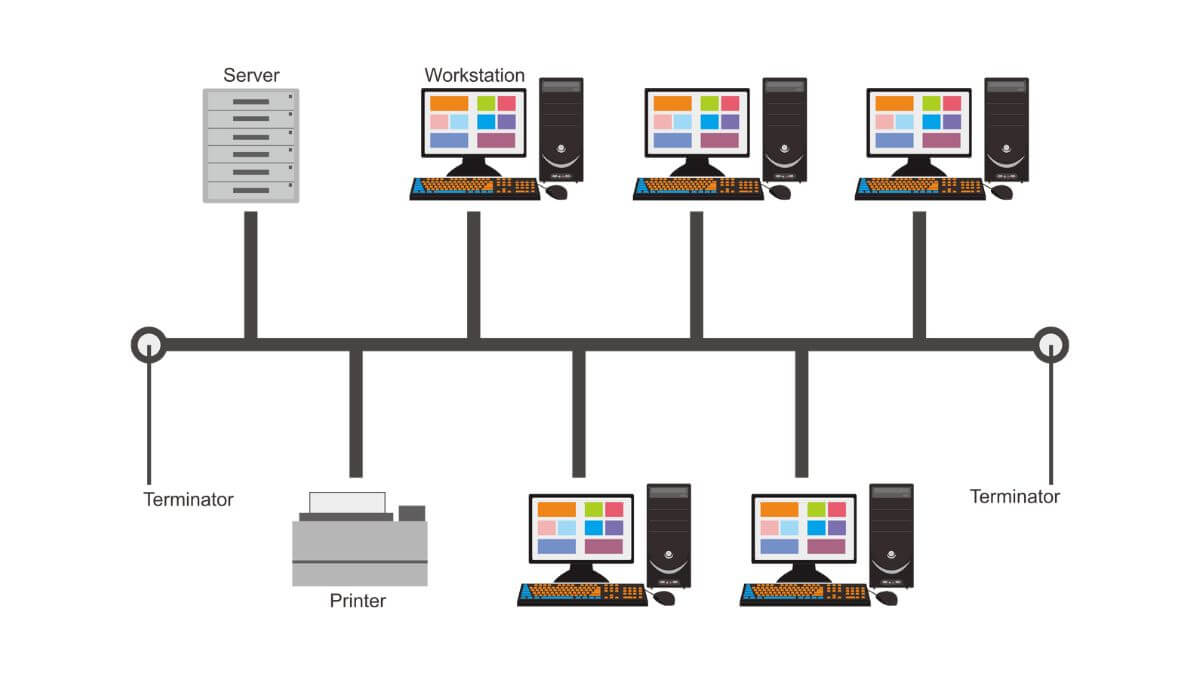
By this type of topology, if one node goes faulty, all nodes may be affected as all nodes share the same cable for sending and receiving information. The cabling cost of bus systems is the least of all the different topologies. Each end of the cable is terminated using a special terminator.
Advantages of Bus Topology
Bus topology offers several advantages for network configurations. One advantage is its simplicity and cost-effectiveness, as it requires minimal cabling compared to other topologies. This makes it suitable for small to medium-sized networks with a limited budget. Another advantage is its ease of installation and scalability, allowing for the addition of new devices without disrupting the network.
Further, bus topology has a high level of reliability, as any failure in one device does not necessarily affect the entire network. This makes troubleshooting and maintenance easier compared to other topologies.
Disadvantages of Bus Topology
One major drawback is that the entire network can be brought down if there is a break in the main cable. This can result in all nodes on the network losing connectivity and disrupting communication. Another disadvantage is that as more devices are added to the network, the overall performance can degrade due to increased traffic and collisions.
Additionally, bus topology is not very scalable and can become inefficient in larger networks. Finally, troubleshooting can be more challenging in bus topology as identifying the source of network issues can be difficult without proper diagnostic tools.
Ring Topology
“Ring topology” is a common type of topology used for Ethernet networks. It consists of a single link routed around the network in a ring. The ring is formed with other nodes with which it forms an interconnect or ring. Ring topologies are sometimes referred to as daisy chains due to the shape of the network.
A typical ring topology will connect two or more devices in a chain. In the two-node case, the devices are connected directly to each other. If more than two devices are connected, a single physical link will be connected in a loop between each pair of devices, as shown in the figure on the right.
There is a direct point-to-point link between two neighbouring nodes (the Next and the Previous). These links are unidirectional, ensuring that a node’s transmission traverses the whole ring and returns to the node, which made the transmission as shown in the figure.
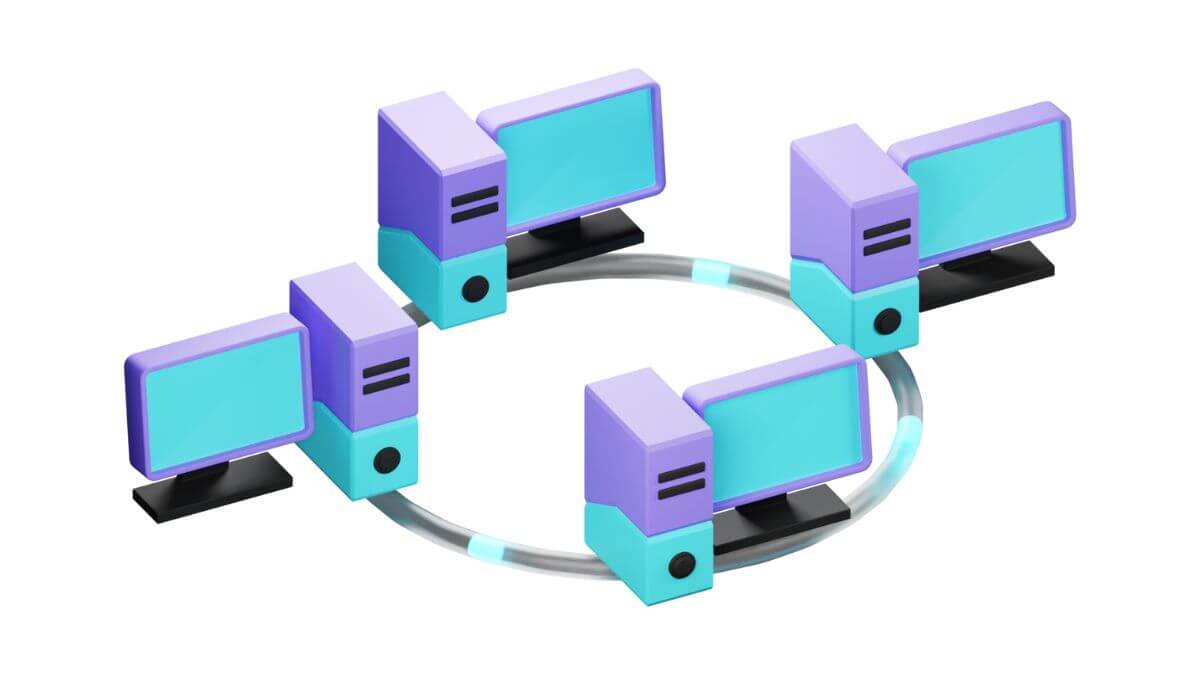
Information is sent from one node to the next as it moves around the ring. To ensure that each packet of data transmitted to the rink arrives at its destination, it is prefixed with the station’s address to which it is being sent.
In response to the arrival of a packet of data, the node first checks to see if the packet’s address is the same as its own; if it is, it then collects the data contained inside the packet. If the packet does not belong to it, it sends it to the next node in the ring. Faulty nodes can be isolated from the ring. When the workstation is powered on, it connects itself to the ring. When power is off, it disconnects itself from the ring, allowing the information to bypass the node. The most common implementation of this topology is a token ring. A break in the ring causes the entire network to fail. Individual nodes can be isolated from the ring.
Advantages of Ring Topology
- Ring networks offer high performance for a small number of workstations or for larger networks where each station has a similar workload.
- Ring networks can span longer distances than other types of networks.
- Ring networks are easily extendable.
- Unlike Bus topology, Ring topology has no signal loss because the tokens are data packets re-generated at each node.
Disadvantages of Ring Topology
- Relatively expensive and difficult to install.
- Failure of one computer on the network can affect the whole network.
- It is difficult to find faults in a ring network.
- Adding or removing computers can disrupt the network.
- It is much slower than an Ethernet network under normal load.
Star Topology
Star topology uses a central hub through which all components are connected. In a Star topology, the central hub is the host computer, and a terminal is at the end of each connection, as shown in Figure.
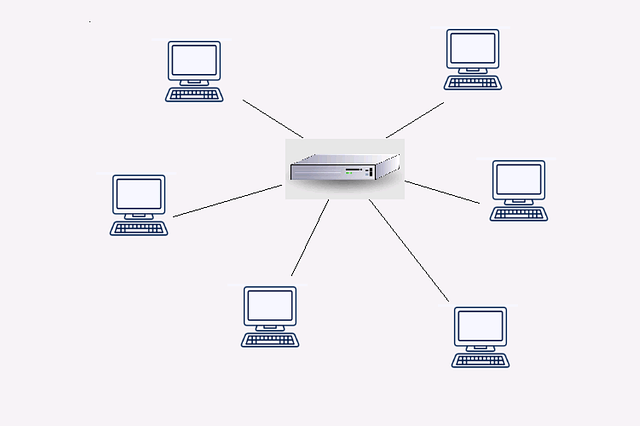
Nodes communicate across the network by passing data through the hub. A star network uses a significant amount of cable as each terminal is wired back to the central hub, even if two terminals are side by side but several hundred meters from the host.
The central hub makes all routing decisions, and all other workstations can be simple. An advantage of the star topology is that failure in one of the terminals does not affect any other terminal. However, the failure of the central hub affects all terminals. This topology is frequently used to connect terminals to a large time-sharing host.
Advantages of Star Topology
- It is more reliable (if one connection fails, it does not affect others).
- The centre of a star network is a good place to diagnose network faults, and if one computer fails, the whole network is not disturbed. The Hub detects the fault and isolates the faulty computer.
- It is easy to replace, install, or remove hosts or other devices; the problem can be easily detected.
- It is easier to modify or add a new computer without disturbing the rest of the network by simply running a new line from the computer to the central location and plugging it into the hub.
- Use of multiple cable types in the same network with a hub.
Disadvantages of Star Topology
- It is expensive to install as it requires more cable; it costs more to cable a star network because all network cables must be pulled to one central point, requiring more cable length than other networking topologies.
- If the central hub fails, the whole network fails to operate.
- Many star networks require a device at the central point to rebroadcast or switch the network traffic.
Mesh Topology
Devices are connected with many redundant interconnections between network nodes. In a well-connected topology, every node has a connection to every other node in the network.
The cable requirements are high, but there are redundant paths built-in. Failure in one of the computers does not cause the network to break down, as they have alternative paths to other computers.
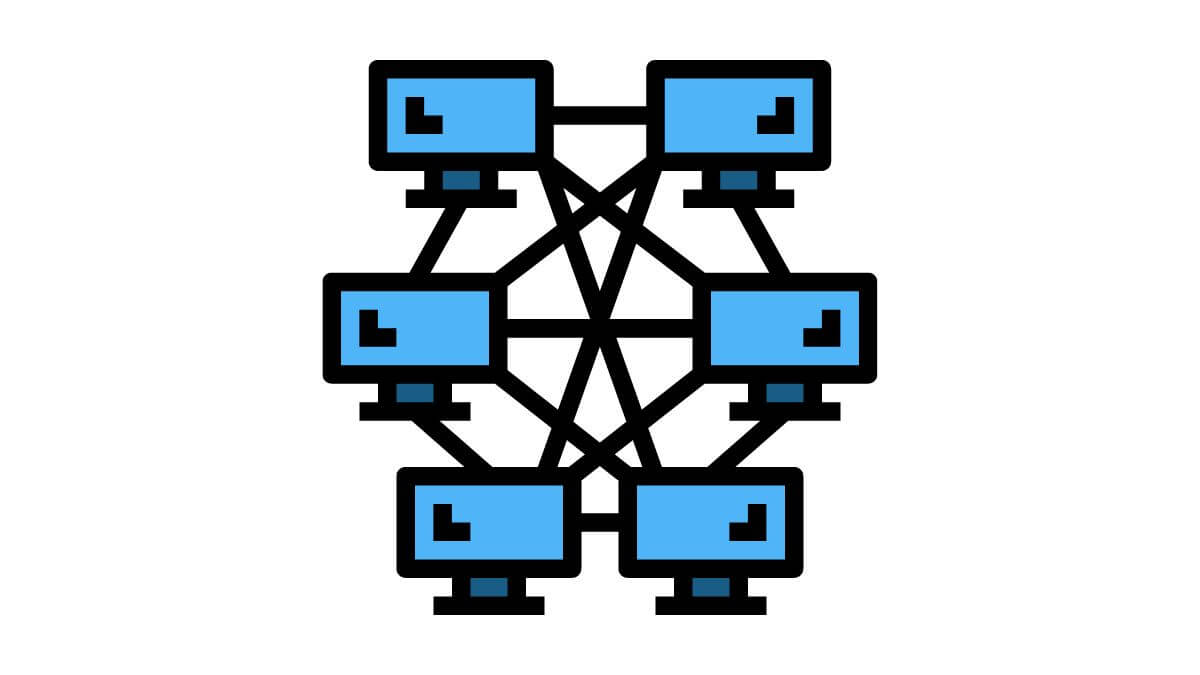
Mesh topologies are used in the critical connection of host computers (typically telephone exchanges). Alternate paths allow each computer to balance the load to other computer systems in the network by using more than one of the connection paths available.
Therefore, a fully connected mesh network has no (n-1) /2 physical channels to link n devices. To accommodate these, every device on the network must have (n-1) input/output ports.
Advantages of Mesh Topology
- Yield the greatest amount of redundancy if one of the nodes fails where network traffic can be redirected to another node.
- Point-to-point link makes fault isolation easy.
- Privacy between computers is maintained as messages travel along a dedicated path.
- Network problems are easier to diagnose.
Disadvantages of Mesh Topology
One major drawback of mesh topology is the high cost of implementation and maintenance. Since each node must be connected to every other node directly, this requires an extensive amount of cabling and hardware equipment, such as switches and routers. As the number of nodes increases, so does the complexity and cost of setting up the network.
Another disadvantage of mesh topology is that it can suffer from latency issues due to excessive packet routing. The more nodes in a network, the greater the amount of traffic that must be processed by each router or switch on the path between two endpoints.
Tree Topology
A tree topology is a topology in which all the components are interconnected hierarchically. When you build a network topology in a tree, you usually think of a mesh architecture.
The most common structure or topology is a tree topology. A tree topology is a LAN topology in which only one route exists between any two nodes on the network. The connection pattern resembles a tree in which all branches spring from one root.
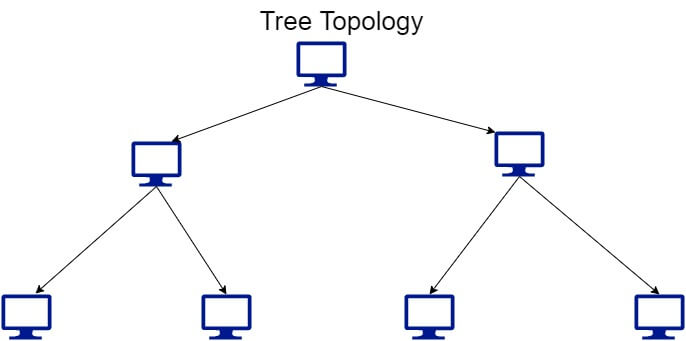
Tree topology is a hybrid topology. It is similar to the star topology, but the nodes are connected to the secondary hub, which is connected to the central hub. In this topology, groups of star-configured networks are connected to a linear bus backbone.
Advantages of Tree Topology
One key advantage of tree topology is its scalability. As the network grows, additional nodes can be easily added to the existing branches, or new branches can be created without affecting the entire network’s performance. Additionally, tree topology allows for easy management and troubleshooting, as each branch can be individually monitored and maintained.
Another key feature of tree topology is its fault tolerance. In case of a failure in one branch or node, only that particular branch or node will be affected; other parts of the network will remain operational. This feature ensures minimal downtime and prevents complete system failure due to minor errors in any part of the network.
Disadvantages of Tree Topology
One of the main drawbacks of tree topology is its dependency on the root node. If the root node fails, the entire network will be impacted, causing significant downtime and data loss. Additionally, if multiple nodes are connected to one branch or leaf, it can lead to congestion in that particular section of the network. This can result in slow data transfer rates and poor network performance.
Another issue with tree topology is its scalability limitations. As more nodes are added to the network, it becomes increasingly difficult to manage because each new node requires additional resources from the root node. This can cause delays in processing requests and reduce overall efficiency.
Which is the Best Network Topology?
The varieties of network topology usage will vary based on the organisation and the requirements for network configuration. For instance, will printers be connected to each computer system, or will only computers be connected to the network? This would affect the network topology’s application. The best network topologies for an organisation would be the star topology or the mesh topology, as these networks can continue to function if there is a failure in the cabling and the organisation must be connected to the network at all times to access vital patient information.
The overall size of the organisation will have a significant impact on the network topology they choose. The size of the organisation and the quantity of hardware that must be connected to the topology will also determine the optimal topology for the organisation. If it is a large organisation, it would make sense to have a topology such as a star topology, in which multiple computer systems are connected to a central point. Connected workstations and printers would also make this a suitable network topology. Some larger organisations have multiple devices linked to a single shared printer. A bus or ring topology may function and be less expensive for the organisation if it is a smaller business. The mesh topology would be advantageous for all organisations, but it is quite costly and complex.
Also Read: Differences between Switched Networks and Routed Networks
Conclusion
Network topologies simply describe how a company’s network is connected, which in turn governs how the computer systems communicate with one another. Network topologies may come in a variety of shapes and sizes for a company. The first one is the ring topology, in which every networked computer is surrounded by other computers in a circle. The second one is a bus topology, whereby everything is connected in a single straight line. This indicates that the process begins at one computer system, connects to the next, and so on, until you reach the last one. The third topology is a star topology, and in this topology, each computer is connected to a hub independently. Each machine in this topology has its own connection to the hub. The mesh topology, which is the fourth topology, appears to be the most difficult and expensive topology but is likely the best at preventing network failures.

